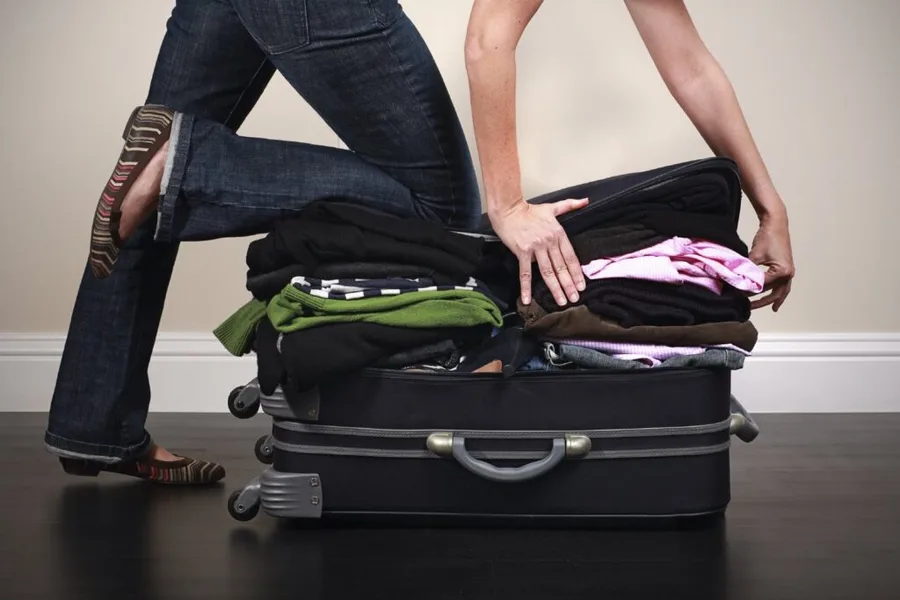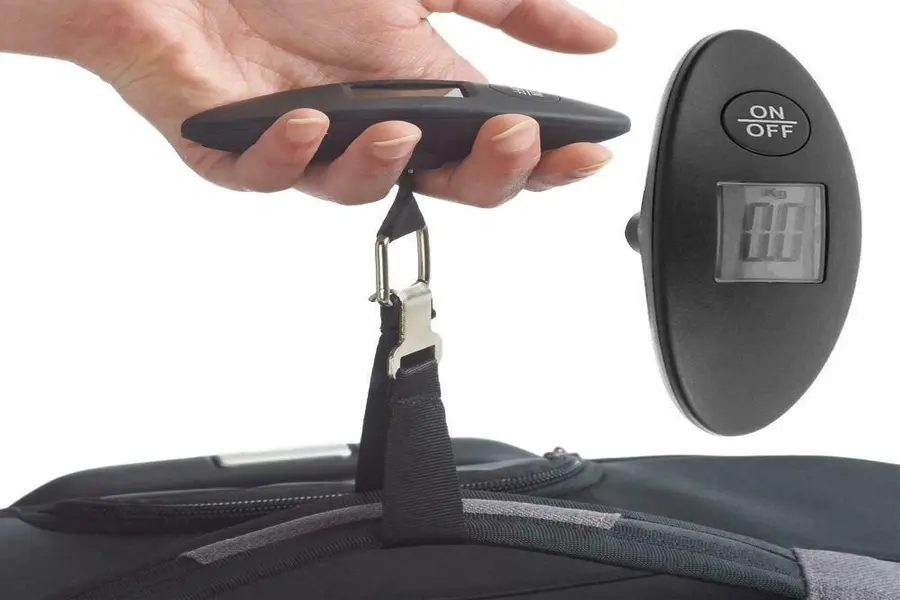On your travels you surely want to feel free like a bird, not packed like a mule! That’s why it’s worth taking the time to pack light.
Forcing yourself to pack lighter and smarter lets you avoid checking in your luggage. Not only that, you can benefit by saving money, time, hassle, and just being so much more mobile during your trip.
I’ve been travelling all my life (and as a travel blogger for over 10 years) and my packing system has only become more streamlined over time. I keep my packing weight well under 10kg even for long trips.
It wasn’t always that way! I, too, once packed like a doomsday prepper, filling my bag with completely unnecessary gear.
But with a little work and a minimalist approach, you can easily get it down to just a carry-on bag. Here’s exactly how.
BENEFITS OF PACKING LIGHT
First, let’s consider why you should pack light!
Save money on flights
You can avoid check-in fees on many airlines by having carry-on-size luggage only. This helps with shorter-distance flights, but increasingly long-haul flights now also offer the option of a ‘basic economy’ fare that only includes carry-on luggage.
Easier to pack and unpack
With less stuff to rummage through it gets easier to pack and unpack, easier to find things, and harder to lose them.
Always in control of your luggage
Light luggage makes it easier to always keep it with you, instead of handing it over to porters, luggage handlers, and others who could mishandle your belongings.
Increased mobility
Packing light simply makes it easier to travel by reducing the effort it takes to move around. Stairs, cobbled streets, and other terrain become easier to navigate. Your back and feet won’t hurt as much. By packing minimalistically, you can change locations much more easily and often.

RULES FOR MINIMALIST TRAVEL
Packing wisely is an important part of any successful trip, as it can help you to travel more comfortably and avoid unnecessary hassle. Here are some tips for packing wisely before traveling:
1. Pack the must-haves, not the nice-to-haves
If you’re going on a big or far-away trip, you can quickly end up packing ever more things just because ‘more stuff’ feels somehow comforting or safe. But resist this urge to be overprepared! Think long and hard about every item, then eliminate anything you don’t absolutely need.
2. Bring versatile instead of special-case items
Focus on items that will be useful to you all the time or that have multiple uses. Think twice about anything you’ll use only on unique occasions.
Keep in mind you can often rent gear locally (e.g. trekking or sports gear), or find a cheap temporary fix instead of carrying something for one-time use. For clothing, packing layers is more versatile (e.g. a shirt can be a base layer in a cold climate or a top layer in a warm climate).
3. Pack at most one week’s worth of clothing
It’s much easier to do laundry than to carry weeks’ worth of clothing. Pick some versatile favorites with a simple color palette so that you can easily mix and match.
4. Use a packing list (if it’s your own!)
“Use a packing list” is a mantra you see repeated everywhere. As far as I’m concerned this doesn’t mean just grabbing packing lists from the web and copying them line by line. This approach is very likely to cause you to overpack!
Most packing lists out there are padded with unnecessary stuff as they compete to be the ‘most complete’ (or to promote various products), so just pack what seems most sensible for your trip. However, you can write down your own personal packing list as a reminder for future trips — then add or remove things over time based on what you’ve learned.
5. Don’t pack in a panic
It’s best to pack at least a day before the start of your trip. If you try to pack just hours before departure, you’re more likely to quickly stuff your luggage with things you don’t need. (I’m a professional traveller and still pack about 3 days in advance, just to do it in a calm and controlled way!)
HOW TO PACK LIGHT
Step 1: Weigh your luggage
It’s hard to pack light when you don’t know how much you’ve already packed!
Be sure to use a scale to prevent any unfortunate surprises at the airport. This also helps you prioritize lighter items.
Choose the practical Scale, it will be your friend wherever you travel

Step 2. Choose the right luggage
It’s easier to pack well when you have the right luggage, so investing in some nice luggage can be highly worth it.
There are two things to consider: size and weight.
Using a smaller luggage size is such a great way to force yourself to pack lighter.
You see, a funny thing happens when you’re using a big suitcase or backpack: even if you don’t intend to fill it completely, you will probably find a way to do it. Simply having more available space can often trick you into overpacking.
I see it all the time with backpackers and adventure travelers carrying humongous 70 or even 80-liter backpacks around the world. Merely by using a bag that’s too big to start with they end up waaaay overpacking. They sweat, they curse, they toil — even when it’s not at all necessary to pack so much for most types of trips.
So instead, I suggest getting something with a maximum capacity of around 35 to 40 liters. This is the typical volume of a carry-on compliant size bag.
It’s true that for some trips this might not be quite enough. For example, for a very long trip through multiple climates that requires lots of different (winter) gear. Personally, I find a carry-on bag sufficient in most cases. I even traveled around the world for 2 years straight with just a carry-on.
Choosing lightweight luggage
The weight of the luggage itself also makes a difference. Some backpacks and suitcases use heavier materials or have lots of extraneous features making them heavier. This can needlessly weigh you down.
I usually reach for my trusty Osprey Farpoint (check it at Amazon). It’s carry-on sized and weighs about 1.6kg or 3.5 lbs. That’s about half a kilo less than many other more elaborate backpacks, instantly freeing up some of that precious airline weight allowance.
Mind you, I’m not suggesting you throw your perfectly fine luggage in the trash to buy something just a little bit lighter. But if you’re getting into one-bag travel or buying new gear anyway, then you could choose a lighter option.
Step 3. Pack the essentials
Alright, time to pack. Let’s do this!
What follows is exactly how I pack.
Of course, this is only an example. Based on your type of trip, travel style, or gender you may want to pack other things.
Clothing
I’m fairly minimalistic when it comes to clothing. Regardless of trip length, I never pack more than about a week’s worth of clothes.
I find that it’s just easier to wash clothes during a trip than to have to pack a giant wardrobe.
- 6 or 7 shirts or t-shirts — only ones that I know I’ll be happy to wear regularly.
- 7 pairs of underwear. Some say you should bring as few as 3 (one to wear, one to wash, and one to dry), but I prefer having fresh underwear regularly, thank you very much. Maybe I’m just a little weird like that!
- 3 pairs of pants/trousers. For hot climates, 2 of these will be shorts
- 3 pairs of socks for tropical climates, about 7 for temperate or cold climates
- 1 sweater or hoodie
- Swimshorts
- Nightwear
- Wind/rain jacket
- Cap or hat
In tropical destinations, I just sleep in shorts and a tank top. In colder climates, I’ll add a pyjama.
Winter trips do need some additional bulky stuff, such as jumpers, a hat, a coat, etc. Luckily, many of these outerwear items can be on your body most of the time, so not all will need to be packed. You can also layer your clothes so you can use them flexibly for various climates.
Sometimes it can be worth buying multi-functional clothing. For example, these zip-off travel pants can be used both as trousers or as shorts. (Check out these dual-purpose zip-off pants at Amazon)
My jacket is a Patagonia Torrentshell 3L. I’ll be honest: I used to think of this type of premium brand as overpriced and unnecessary, but then my partner got me this jacket and I ate a thousand crow. It’s legit become my favorite travel item! It’s lightweight, perfectly protects against the elements, and it feels amazing to wear (no, this is not an ad!). It also neatly packs into one of its own pockets.
I now hugely see the value in investing in some high-quality outer layer. A great jacket lets you brave the elements, so it’s an essential travel tool.
I’m not sure why people recommend umbrellas. They are bulky and prone to getting damaged in strong winds — and umbrellas can’t keep you warm. A good jacket is a lot more versatile.
Finally, it can be worth investing in some merino wool clothing. This material is expensive but has many advantages; it provides warmth when it’s cold, keeps you cool when it’s hot, has the incredible ability to stay warm even when wet, and dries much faster than cotton.
Merino is quite pricey though, so I find it worth it mostly for hiking. Even on multi-day treks, you can keep stinkiness at bay with some merino wool socks and a merino t-shirt.
Footwear
Footwear is hugely personal, but here’s what I pack:
- 1x hiking or comfortable walking shoes
- 1x backup/everyday shoes (usually low-top canvas sneakers)
- 1x flip-flops
The main travel shoes are a pair of Merell shoes. you can chose a model that doesn’t look too technical so you can also wear them in non-hiking situations.
As a second pair, you can bring low-top Converse All-Stars or similar canvas shoes. That’s because these fold up nicely and take up very little space. When travelling in a tropical climate, you might bring sandals instead of a second pair of shoes.
Toiletries
When it comes to toiletries the most important thing is not to pack full-size bottles. They are just too bulky! Liquids can’t exceed 100ml anyway when flying carry-on.
One solution is to get some empty 100ml containers and pour in some of your products. If you can’t live without your favorite 100% organic cocoa wild fig truffle oil shampoo, then this is definitely the way.
(Seriously though, not everyone likes the complimentary products offered by hotels. In hostels or budget hotels, you might not get such amenities anyway, especially in adventure destinations. It’s nice to pack your own.)
I recommend you not to bring any liquid soap at all. That’s just because it weighs much less to pack a simple soap bar, which lasts much longer too.
Fun fact: 70% to 90% of the weight of shower gel is just water!
For a longer trip, I recommend you to pack a shampoo bar. These work just like a soap bar: simply rub it in water and you’ll get some lovely foamy shampoo.
A 100 ml shampoo bar can last as long as one big 750 ml bottle. Assuming you wash your hair once every few days, one bar can last you many months, which is amazing if you’re a long-term traveller. By using bars you also remove any risk of spills during transit.
Shampoo bars are not too difficult to find, you can find several shampoo bar brands on Amazon.
You can store your toiletries in wash pouch, you can choose your favorite colour LOL..
If you’re staying in hostels then you’ll find most don’t offer towels, but plenty of budget hotels don’t either. That’s why I bring a lightweight microfiber travel towel. These weigh at least 10 times less than the average cotton towel. It can also double as a beach towel when needed.
Some may not like the velvety texture, but you are not supposed to actually rub this type of towel on your skin. After showering, use your hands to remove most of the water first, then just gently pat yourself dry.
Microfiber travel towels are fast-drying, which is great if you’re switching between city/accommodations during your trip.
Organization
I use packing cubes for basic organization. if you’re on a budget I recommend this Cubes, or Peak Design packing cubes if you want something nicer.
I keep my dirty clothes in this laundry bag with a drawstring. This keeps the stinky clothes nicely separated.
If you need to pack for multiple climates, consider bringing a compression bag for storing e.g. your winter items when you no longer need them. By slowly sucking all the air out, a compression bag can turn into a nice and flat little pancake. It’s not ideal for items you use all the time, but it’s great for putting things into deep storage.
Finally, if you expect to be in- and around the water it can be worth bringing a waterproof bag. I learned my lesson when I once got my passport and money utterly soaked in seawater on a boat, so now I always put my papers and valuables in a dry bag.
Electronics
Since electronics come in all shapes and sizes, whatever you choose can have an outsize effect on your overall packing weight.
I’ve traveled with numerous electronic devices over the years, including a MacBook, a Dell XPS laptop, a Chromebook, an iPad, and a Kindle. I’ve finally settled on the simplest solution for me: A mini tablet.
My Samsung Galaxy Tab Lite S7 is absurdly light, its modest dimensions are ideal for travel as it will easily fit on a tray table ,its making it far less theft-sensitive than my 1700+ Euro Macbook Air.
Being of the size 12,4 inch and has a lot to offer. Enjoy all your series and games anywhere, anytime. Enjoy the large and vibrant display. Enjoy the rich sound. Enjoy 13 hours in a row thanks to the powerful battery, makes this an ideal travel device.
This mini tablet is perfect for:
- Reading e-books
- Watching video
- Play games
- Backing up travel photos and videos
- Travel research
- Taking quick travel notes
Other electronics:
- In-ear headphones. After losing my expensive Apple AirPods Pro on a flight once, I now just stick to cheap wired headphones. It’s just not as theft/loss sensitive. In any case, I leave my chunky over-ear headphones at home.
- USB-C charger. I’m trying to standardize everything around USB-C: phone, tablet, camera, etc. That way you need just one charger.
- Universal Plug Converter. Many plug types are used in countries around the world. With a converter, you don’t ever have to worry about this.
As a travel blogger, I do need to bring additional gear to document my trips. I primarily use a Micro Four Thirds camera by Olympus. Ultra compact and light, with the first fold-down touch screen of the OM-D series for easy self-portraits, as well as built-in Wi-Fi and Bluetooth to share precious moments with family and friends instantly.
I don’t always bring a drone, but when I do it’s my DJI Mavic Mini 2, which weighs only 249 grams.
Useful items or gadgets
Finally, some (multi-) functional items that I like to pack:
This Buff is made of a special seamless stretchy material. You can use these to create a bandana, sweatband, scarf (great for motorbiking), sleeping mask, or sun guard.
An inflatable travel pillow is pretty compact. I take this on every trips.
USB rechargeable headlamp with is essential for adventure destinations, early morning hikes, etc.
A number padlock is 100% a must if you’re staying in hostels. Get a number padlock so you don’t have to worry about losing the keys. I prefer a small wire padlock that I can also use to secure my luggage during transit.
First aid kit with some essentials. Besides band-aids and such, I also like to include some painkillers, loperamide (to stop diarrhoea) and anti-mozzie stuff, so this also doubles as a travel medication kit.
Another helpful small item is a hook to attach to your luggage. This will let you hang a mug, water bottle, towel, or shoes on the outside of your pack. It’s a great way of creating some extra space or drying out your gear.
I like the HeroCLIP brand of carabiners because these are strong enough to also hang your entire luggage with. This means you can easily hang your backpack on a wardrobe rail, a fence, or on a tree branch.
Backup debit card. I always travel with multiple means of payment. It’s highly worth signing up for a free Wise debit card. Wise actually offers very fair exchange rates between currencies and even free ATM withdrawals abroad (up to a certain maximum).
In general though, if something is too gimmicky or the use case too specific, I tend not to pack it.
Final packing tips
Whatever you decide to bring, one of the best ways to prevent overpacking is not to pack at the last moment! Pack at least one day before.
If you’re in too much of a hurry, you might stress out and stuff your bag too full. If you’ve ever panicked before a trip, you know what I’m talking about.
Oh, one more good rule: try to keep a quarter of your bag empty. This makes loading and unloading easier and this space can be used for storing souvenirs or gifts.























